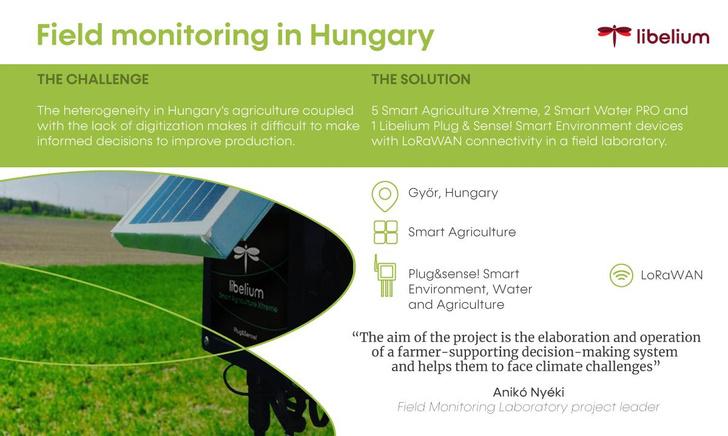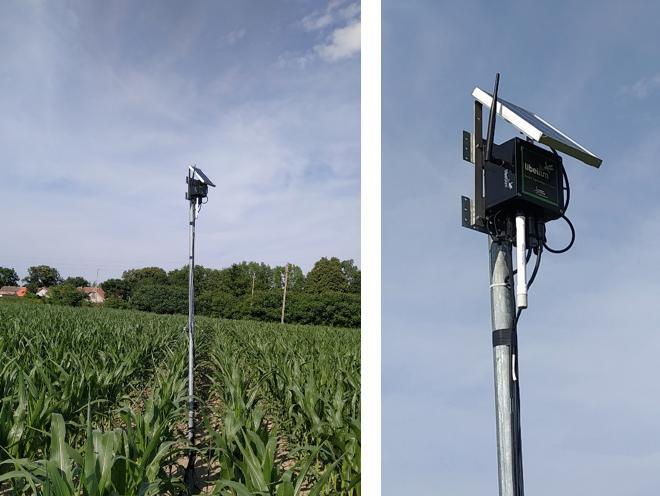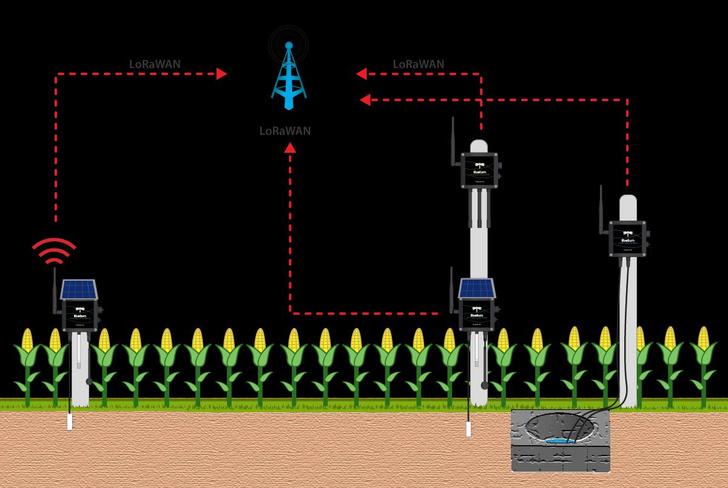Hungarian researchers design a field monitoring project to help farmers in making decisions
Agriculture accounts for 3.2% of the country’s GDP and plays an important role in rural development. To get an idea, in 2018 Hungary produced 7.9 million tons of corn, making it the 15th largest producer in the world.
However, agricultural land is a tremendously heterogeneous system. The soil components show great variation and mutability both in terms of kilometer extension and time dimension since the parameters can change during two measurement dates. All these factors make the result of a harvest vary in quantity and quality from one point to another.
To help the national agricultural sector, Széchenyi István University has designed a smart agriculture project with Libelium Agriculture, Water and Environmental sensors, which they have named the “Field Monitoring Laboratory”. The Faculty of Agricultural and Food Sciences is located in Mosonmagyaróvár, in western Hungary. The faculty farm extends its field crop production to more than 400 hectares.
» What has been the challenge of this field monitoring project in Hungary?
The heterogeneity in Hungary’s agriculture coupled with the lack of digitization makes it difficult to make informed decisions to improve production.
» Which Libelium solutions work in this project?
5 Libelium Smart Agriculture Xtreme, 2 Smart Water PRO and 1 Smart Environment devices with LoRaWAN connectivity in a field laboratory.

The main objective of this project is to collect information on the soil and climate (also from the surroundings of the field) and their effects on the production of corn and wheat. In this way, researchers will be able to offer information of great help for the decision-making of local farmers.
This Field Monitoring Laboratory in Hungary includes five Plug & Sense! Smart Agriculture Xtreme, two Plug & Sense! Smart Water and one Plug & Sense! Smart Environment. The researchers installed the devices in two crop fields (6 ha and 15 ha) of corn and wheat in different types of soil.
- The two Smart Water nodes have been installed in an artificial water pit to detect the pH and the nitrite and nitrate content of the soil water.
- The five Smart Agriculture devices have been installed in the crop, on different types of soil. The idea is to compare soil and growth circumstances (eg, soil electrical conductivity, soil water content, leaf, and weather conditions).
- The Smart Environment node monitors environmental soil conditions such as CO2 and ammonia.
In addition, UAV (unmanned aerial drones), robots with artificial intelligence interfaces, and remote sensing techniques complement the installation . These results contribute to the analysis of the effects of climate change concerning the development of decision support models.

Data collected, stored, and analyzed with LoRaWAN connectivity
Once in the cloud, different techniques analyze the data automatically collected (for example statistical methods, physiological models of crops, and artificial intelligence). Until now, this data was collected manually in a difficult, long, and expensive process. This new network of sensors automatically collects parameters (soil, environment, atmosphere, and soil water variables) as ‘Big Data’ and provides clearer results than ever.

A software platform, specially designed by the Hungarian “Field Monitoring Laboratory”, receives data compiled in real-time and it is stored and analyzed. Furthermore, this information is accessible from any computer or smartphone, allowing the research team to automatically obtain data and make decisions in a faster and more efficient way.

The information collected by the Libelium sensors is sent directly to Antenna Hungária‘s Loriot LoRaWAN Cloud. AH-s is a state company based in Budapest, collaborating in this deployment, which is working on the design of a LoRaWAN network throughout the country. In this manner, the crop monitoring project also contributes to the implementation of LoRaWAN networks in Hungary, consolidating the Internet of Things and digitization in agriculture. From this cloud, the University receives the data in its servers, where they can develop dashboards and applications.

A pioneering project for the digitization of agriculture in Hungary
Hence, the “Field Monitoring Laboratory” has become the first Agro-IoT project. Now, they have a cutting-edge data collection standard and method for the production of sustainable precision crops to achieve agricultural digitization, new scientific results, and service extension for farmers.
Research activities began in 1998 with site-specific performance mapping. The research team has a two-decade track record in the field of digital data collection. Indeed, they can fill the agricultural digitization system with historical data.

With the idea of increasing the production of sustainable crops, the laboratory works from different viewpoints:
- Automation of data collection
- Remote monitoring of microclimatic parameters within the crop field
- Access real-time data from any device at any time
- Collect data to inform both current and future work
- Troubleshooting with detailed analysis
This system allows farmers to make more precise decisions to better adapt to changes and produce safe, high-quality food while preserving the environment, contributing to sustainable development. Thus, in the years to come, Hungary will not only improve its position in the world ranking of corn and wheat producers but will also improve the quality of its production so the farmers can monetize the data.
The project is financed by the European Union and the Hungarian Government from the project ‘FIEK – Center for cooperation between higher education and the industries at Széchenyi István University under grant number GINOP-2.3.4-15-2016-00003 and it was partly supported by the “Thematic Area Excellence Program” of the National Research, Development and Innovation Office (TUDFO/51757/2019-ITM).
